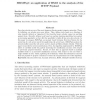47 search results - page 5 / 10 » Cooperative Intrusion Detection for Web Applications |
DIMVA
2009
13 years 8 months ago
2009
We demonstrate that the browser implementation used at a host can be passively identified with significant precision and recall, using only coarse summaries of web traffic to and f...
JMLR
2010
13 years 2 months ago
2010
Zero-days attacks are one of the most dangerous threats against computer networks. These, by definition, are attacks never seen before. Thus, defense tools based on a database of ...
WSE
2006
IEEE
14 years 1 months ago
2006
IEEE
The widespread adoption of web services as an instant means of information dissemination and various other transactions, has essentially made them a key component of today’s Int...
EASSS
2001
Springer
14 years 3 days ago
2001
Springer
This contribution presents a knowledge-based model of the agents’ mutual awareness (social knowledge) and justifies its role in various classes of applications of the concept of...
ENTCS
2006
13 years 7 months ago
2006
We propose a formal method to validate the reliability of a web application, by modeling interactions among its constituent objects. Modeling exploits the recent "Multiple Le...

